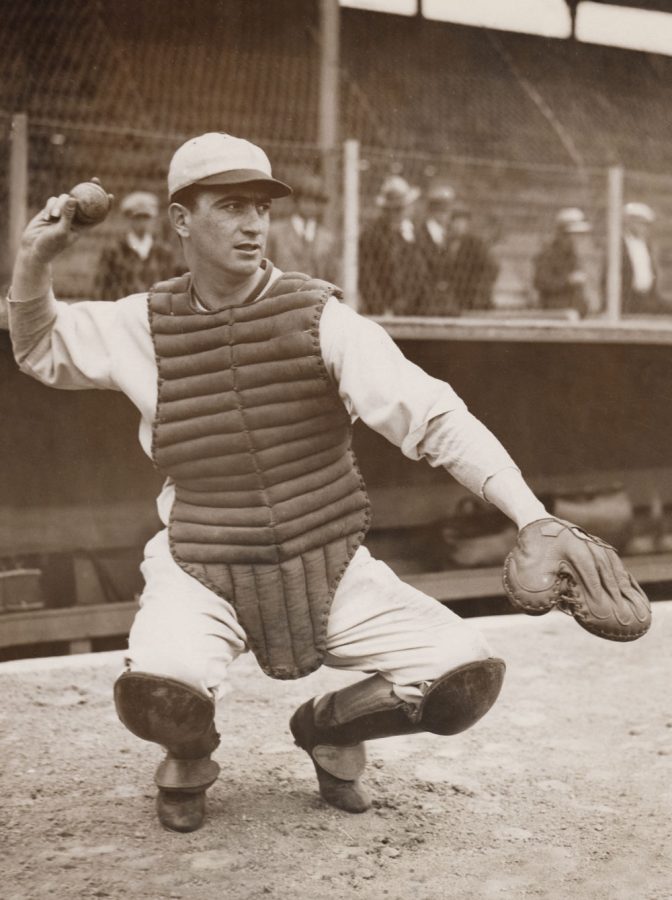Film offers play-by-play of two unlikely careers
Published June 27, 2019
Morris “Moe” Berg was an amazing figure for any era: a major league baseball player, a graduate of Princeton University and Columbia Law School and a World War II spy who spoke at least 10 languages.
Award-winning director Aviva Kempner tells the astounding story of this son of Russian Jewish immigrants, known as the “brainiest guy in baseball,” in her documentary “The Spy Behind Home Plate.”
If you saw the fictionalized version of Moe Berg’s life, “The Catcher Was A Spy,” a 2018 film starring Paul Rudd, you do not know the half of it. That film had only a sliver of the facts. The real Moe Berg was a far more complex, accomplished and brilliant person than the one in that movie, and he comes across as that and much more in “The Spy Behind Home Plate.” Both films were based in part on the biography “The Catcher Was a Spy.”
Kempner, an award-winning director who also helmed “Rosenwald,” already had experience making a documentary about a baseball player with “The Life and Times of Hank Greenberg.”
Berg rubbed elbows with a surprising number of famous figures, ranging from Babe Ruth to Chico Marx to Albert Einstein. In his days with the Office of Strategic Services (OSS), which evolved into the CIA after WWII, Berg met British operative Ian Fleming, who had yet to write his first James Bond novel.
Kempner really dives into the material, painting a well-rounded portrait of Berg’s personal and professional life. The documentary includes interviews with Berg’s friends and family, fellow baseball players and coaches, sports journalists and historians, and figures from his days with the OSS.
Born in 1902 to Jewish Russian immigrant parents, Berg grew up crazy for baseball. He loved baseball from an early age, had a gift for it with a lightning fast arm and strong fielding ability. He excelled in both baseball and academics, but his father, Bernard, valued only academics and disdained sports.
Berg’s other passion was for languages, which he majored in at Princeton, from which he graduated magna cum laude. Berg grew up in an era of open anti-Semitism, when many universities limited the number of Jewish students they would take. But with his top grades and baseball skills, Berg was the very picture of the scholar-athlete and gained admittance to Princeton despite its restrictions. On the ballfield, he communicated with his teammates in Latin – or Sanskrit, if the other team knew Latin.
Berg played 15 seasons in the majors, retiring in 1939 at age 37. He was primarily a shortstop before becoming a backup catcher in 1927 with the Chicago White Sox, and he played that position exclusively for the rest of his career with the Washington Senators, Cleveland Indians and Boston Red Sox.
In his off-seasons, Berg liked to travel. He studied at the Sorbonne, and he attended Columbia Law School.
Berg was known as the “brainiest guy in baseball,” but Casey Stengel also called him “the strangest man ever to play baseball.”
Berg spoke at least 10 languages and read newspapers from around the world, traveled extensively and was interested in diverse subjects. His travels included trips to Japan and Germany, which played a role in his later work as a spy.
With his Princeton education and knowledge of languages and world affairs, the dapper Berg was a frequent guest at diplomatic parties during his days playing for the Washington Senators. He was popular with the ladies and known for his skill as a dance partner.
Those connections may have contributed to Berg’s spying career. When the United States entered WWII, Berg, who by then had retired as a player and become a coach, was eager to help his country. With his mastery of languages, he was an ideal candidate for undercover overseas work.
His most critical mission was to find out whether the Nazis were building an atomic bomb. In Switzerland, Berg attended a lecture by German physicist Werner Heisenberg to determine whether Heisenberg was helping the Germans build a bomb; if so, he was to assassinate Heisenberg. Through a conversation with Heisenberg, he was able to determine that Heisenberg was not particularly interested in a bomb and that Germany’s atomic research was far behind that of the United States.
This story has scope, and one amazing moment after another, but Kempner keeps things organized and moving along, as she takes us on this fantastic journey. Still, this is a complex life and a complicated man, and a lot of information is covered in the film’s 101 minutes.
Kempner’s film benefits greatly from footage from an earlier, unfinished documentary, “The Best Gloveman in the League,” using interviews from 1987 to 1991 that were stored at Princeton. These include interviews with Berg’s brother Dr. Sam Berg, his fellow baseball players including Dom DiMaggio (brother of Joe DiMaggio), fellow OSS member and future CIA Director William Colby, astronomer I.M. Levitt and St. Louis sportswriter Bob Broeg.
Archival footage and stills feature Berg with Babe Ruth, with whom he played on a prewar goodwill baseball team trip to Japan, and other famous figures such as Einstein.
Contemporary interviews include Thomas R. McDonough, astrophysicist and author of “Moe Berg: The Secret Files”; novelist and Washington Post columnist David Ignatius; former baseball commissioner Bud Selig; Berg biographer Nicholas Dawidoff; John Thorn, official historian for Major League Baseball; OSS Society president Charles Pinck; and sports columnist Ira Berkow.
Berg’s life was indeed a fantastic one, feeling like something out of fiction yet completely true. Kempner’s documentary is a welcome, fuller exploration of this remarkable Jewish American’s life, highlighting his role as war hero and patriot as well as offering a more complete picture of his baseball career.
‘The Spy Behind Home Plate’
Opens Friday, June 28 at Plaza Frontenac Cinema.
Running time: 1:41















